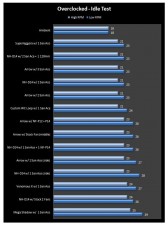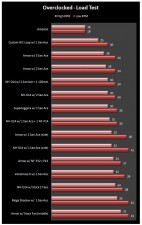TESTING
ÂÂÂ
Test Method
We strapped on a single 120mmx38mm San Ace 9G1212H1011 fan, widely considered one of the best fans on the market due to its under-volting ability (lower RPM) and high static pressure (perfect for heatsinks).
The problem we had with the NH-D14 was that Noctua supplies two fans with the cooler, both 25mm thick. The Noctua cooler can’t accommodate 120x38mm fans in the middle, so with regard to the three-fan test, we used a high performance & static pressure Scythe S-FLEX SFF21F 1600RPM fan in the middle of the D14 with two San Ace 9G1212H1011 either side. For comparison, we also used the same stock fan setup the NH-D14 comes with on the Arrow.
Load testing gives a real indication of performance levels. For this we used OCCT and set each test was run for thirty minutes on each cooler; with the maximum temperature being taken from the CPUID Monitor. We also took into account speed levels of the fans. Addtionaly we also tested the fans on each coole,r for idle and load at its lowest and highest RPM using a fan controller to measure the difference in cooling performance.
Idle testing was taken after an OCCT run had finished. We allowed a ‘cooling off period’ of fifteen minutes for the idle test. The minimum temperature was again taken from the CPUID Monitor.
In this test we used an overclocked AMD system with a fresh copy of Windows 7 64Bit Ultimate. The Phenom II 705e chip was not unlocked as doing so would prevent us from monitoring temperatures within the Windows environment.
Cool & Quiet was disabled in the BIOS as well as any other energy saving features. OCZ Freeze was the thermal interface material of choice.
Test System
- AMD Phenom II X3 705e @ OC 4.0Ghz w/ 1.5v
- Gigabyte GA-MA790FXT-UD5P
- Sapphire HD 4670 512MB Ultimate
- 2GB Super Talent Project X @ 1600Mhz 7-6-6-18
- 320GB WD AAKS Caviar Blue
- Corsair VX 450W w/ Sharkoon 1000 “Golf Ballâ€ÂÂ
- Windows 7 Ultimate 64Bit
The results
All tests were run a minimum of three times (each run was followed by a remounting of the heatsink) and only best results are represented.
*Please note. Testing was done out of case. Previous results are shown below from previous testing of coolers from past reviews – same test conditions were used today.
Analysis
If we start by comparing the two dual tower heatsinks using the NH-D14′s stock Noctua P12 & P14 fans, we see the Arrow 1°C better off on both low and high RPM testing on the overclocked, loaded system. This suggests the Arrow is better at dispersing heat than the NH-D14. Perhaps having four large eight mm heatpipes is better than the six from the D14. Cogage told Overclockers Tech that they performed some testing with six heatpipes and found that utilising four large heatpipes performed better for them as we can see here compared to the NH-D14.
When using one San Ace 120x38mm fan straped on the side of both NH-D14 & the Arrow, we see little improvement between the two coolers apart from 1°C advantage on the low RPM test in favour of the Arrow. However, once there were two San Ace fans mounted upon each cooler, we can see the Arrow start to pull away from NH-D14 ever so slowly as seen on the loaded, high RPM test – being 1°C ahead of the NH-D14 with 29°C. However, low RPM temperatures remained the same.
Moreover, once we fitted three San Ace fans (and what a joy to see it was!), we saw the Arrow manage to hit a great 28°C on load testing at high RPM – just 3°C behind water-cooling with one San Ace on the XSPC RX120 rad on high RPM. When utilising a similar setup on the D14, by using a high performance 120X25mm fan in the centre; low RPM temperatures remained the same as the Arrow! However when it came to the high RPM test, the NH-D14 was 2°C behind the Arrow at at 30°C vs. 28°C.







 Posted in
Posted in 

